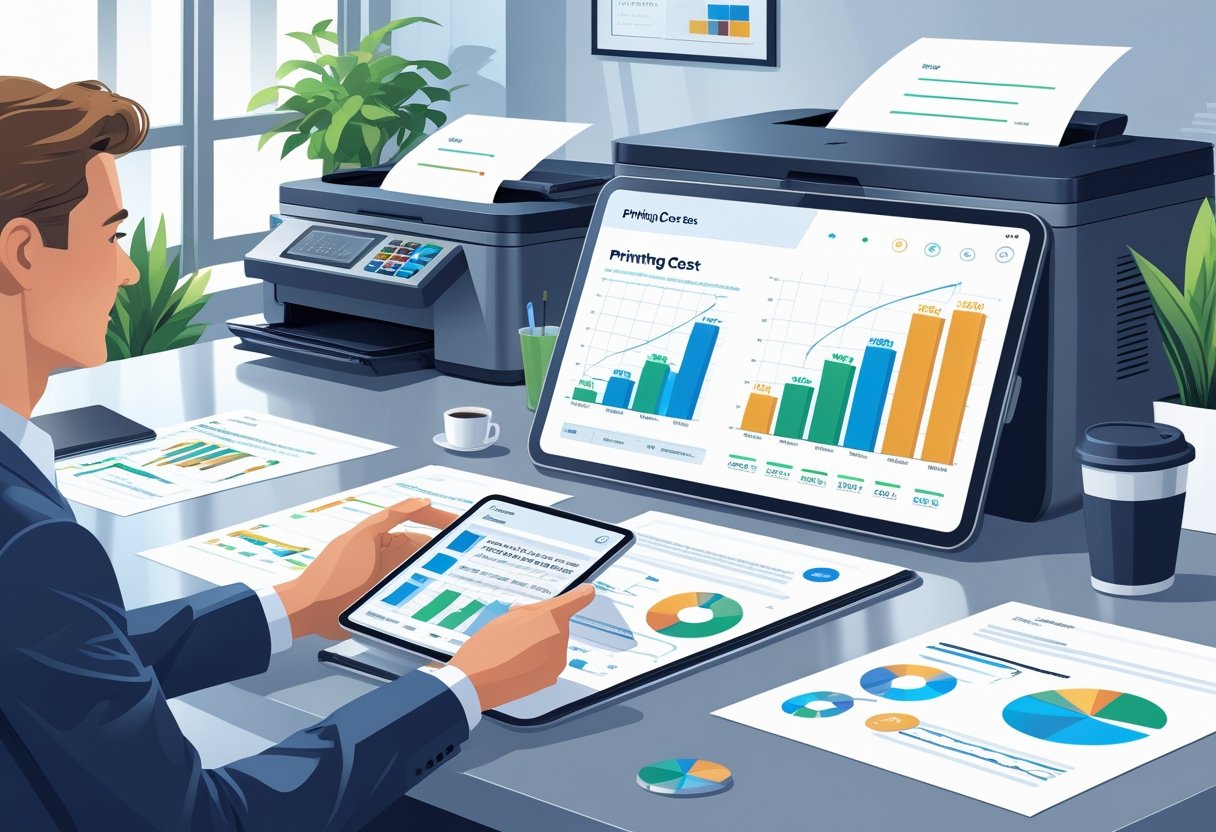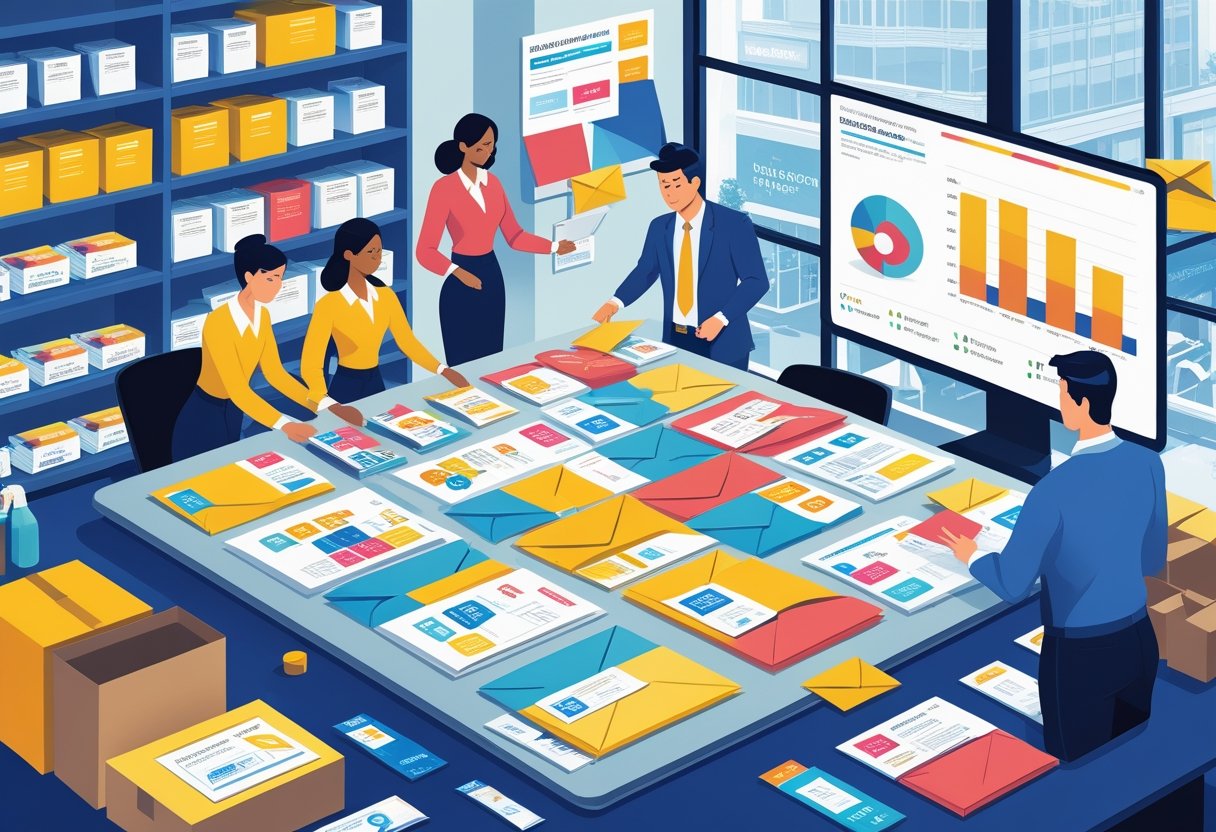Navigating the complexities of printing costs is essential for any business aiming to maintain budget control and operational efficiency. A printing cost estimator empowers you to accurately forecast expenses, ensuring that your projects remain within budget while optimizing resource allocation. With the right tools, you can input variables like materials, labor, and volume, allowing for informed decision-making.
At Mail Processing Associates, we specialize in providing comprehensive mailing and printing solutions tailored to your unique needs. Our expertise ensures you gain access to the right estimating tools to streamline your processes and reduce unnecessary costs. By choosing our services, you leverage our knowledge and commitment to help your business thrive in a competitive market.
Understanding your printing expenses can directly impact your profitability. With a printing cost estimator, you can gain insights that guide your choices and improve overall efficiency in your projects. Trust Mail Processing Associates to support your quest for accuracy and savings in your printing operations.
Understanding Printing Costs for Businesses
Printing costs can quickly accumulate for businesses, encompassing a range of direct and indirect expenses. Understanding these costs is crucial for effective budgeting and resource allocation. Several key factors influence these expenses, as well as the specific costs associated with printing various materials.
Direct and Indirect Printing Expenses
Direct printing expenses include costs directly linked to print jobs, such as ink, paper, and maintenance of printing equipment. For instance, ink and high-quality paper can significantly affect your overall printing budget. You should also consider color printing costs, which tend to be higher than black and white options.
Indirect printing expenses may include software, labor, and operational overhead. For example, the time employees spend on printing tasks or managing printing processes adds to overall costs. Understanding both direct and indirect expenses can help you more accurately forecast your printing budget. If redundancy and inefficiency exist in your printing processes, it's essential to address these to reduce overall expenses.
Key Factors Impacting Printing Costs
Several key factors influence the cost of printing for businesses. These include printing volume, material quality, and print job complexity. Higher volumes often lead to lower costs per unit, particularly when using offset printing techniques.
Material choice is critical; premium papers and specialized inks, such as those used in business cards and brochures, can increase costs. Additionally, the complexity of a print job—like multi-page documents or intricate designs—may require more resources and time. You can leverage tools like a printing cost estimator to gain insights into your expenses.
Cost of Printing Different Materials
The cost of printing varies significantly based on the material chosen. For example, printing simple documents may be less expensive compared to producing banners or marketing materials that require high-quality color printing.
Typically, business cards are economical for small batches but become cost-effective when ordered in larger quantities. Similarly, brochures may initially appear costly but can offer a superior return on investment if used effectively in marketing campaigns. Utilizing Mail Processing Associates for your printing needs ensures you access competitive pricing while benefiting from tailored solutions for your specific projects.
Investing in a printing cost estimator will help you make informed decisions for your company's printing strategy, optimizing costs and enhancing overall efficiency.
Key Components of Printing Cost Estimation
Understanding the key elements of printing cost estimation is essential for managing expenses effectively. You'll need to consider various factors including the type of paper, ink and toner specifications, printer model and technology, and any finishing or customization options.
Paper Type and Print Volume
Selecting the right paper type significantly affects your printing costs. Different paper weights and finishes lead to varied prices. For example, standard copier paper is more economical than specialty papers like glossy or card stock.
Your print volume also plays a critical role. Higher print volumes can capitalize on economies of scale, reducing the average cost per page. Calculating the total pages needed will aid in estimating the necessary paper quantity, which can ultimately lead to cost savings over time.
Ink, Toner, and Cartridge Considerations
Ink and toner costs can vary dramatically based on the cartridge type and page yield. Page yield refers to the number of pages a cartridge can print before depletion. Knowing the page yield helps you estimate recurring costs effectively.
For businesses, consider using high-capacity toner cartridges that may seem pricier upfront but offer lower cost per page. It's advisable to research ink types as well—dye-based inks are typically cheaper but may fade, while pigment-based inks provide longevity but at a higher cost.
Printer Model, Technology, and Energy Consumption
The choice of printer model impacts not only the print quality and speed but also energy consumption. Certain printing technologies like laser printers consume more energy than inkjet printers. This aspect is crucial if you print frequently.
Additionally, some models come equipped with energy-saving features that can reduce long-term operational costs. Research and select a printer that balances both performance and energy efficiency. Mail Processing Associates offers guidance on selecting the right printer model tailored to your needs.
Finishing and Customization Options
Finishing options can add significant value but also increase costs. Services like binding, lamination, or custom cuts require additional materials and labor. Understanding the specific needs for each project helps you budget correctly.
Customization can enhance the effectiveness of printed materials. However, it’s vital to weigh the benefits against added expenses. Discuss these options with your printing provider to determine the most strategic approach for your business. Mail Processing Associates specializes in comprehensive mailing and printing solutions tailored to optimize these processes.
Using a Printing Cost Estimator for Businesses
A printing cost estimator can significantly enhance your business's efficiency in managing print jobs. By understanding how these tools operate, the necessary data to input, and the implications of printing costs per page, you can make informed decisions that optimize your printing processes.
How Printing Cost Calculators Work
Printing cost calculators function by analyzing various factors associated with your print jobs. These include materials, labor, and equipment usage. By inputting specific data, the calculator can generate a detailed estimate of total costs.
Most calculators allow you to customize inputs based on your requirements. This could involve selecting paper type, ink coverage, and the total number of pages. As you adjust these variables, the estimator provides real-time feedback, helping you compare options efficiently.
Using a reliable print cost calculator is essential for businesses that want accurate and competitive pricing for their print jobs. With Mail Processing Associates, you gain access to advanced tools designed for comprehensive mailing and printing solutions.
Inputting Data for Accurate Estimates
To achieve precise estimates, inputting the right data is crucial. Begin with the type of print job you are undertaking. Are you producing brochures, business cards, or flyers? Specify the paper size, weight, and finish.
Next, consider ink coverage. A full-color job will differ significantly in cost from a black-and-white one. Inputting these details allows the calculator to assess material and operational costs effectively.
Don’t forget labor and turnaround times. Labor costs can vary based on complexity and urgency. Accurate data leads to better budget management, making your print operations smoother and more cost-effective.
Understanding Printing Cost per Page
Calculating printing cost per page is vital for budget considerations. This figure includes both consumables, like paper and ink, as well as operational overheads, such as printer maintenance and energy usage.
The cost per page can help you compare different printers or printing services. A lower cost per page may suggest savings, but ensure you consider quality as well. Sometimes, a slightly higher cost may yield superior results.
Utilizing a printing cost calculator helps break down these costs transparently. It allows you to pinpoint areas for potential savings. With Mail Processing Associates, you can leverage these insights for tailored printing solutions that meet your specific business needs.
Exploring Printing Cost Estimation Tools and Software
Effective printing cost estimation is crucial for businesses to maintain profitability and streamline operations. Utilizing the right tools can enhance accuracy in job costing and improve decision-making processes.
Free vs. Paid Print Estimating Software
Free print estimating software often provides basic functionalities sufficient for small projects or startups. These tools can help you create quotes and manage simple print tasks without incurring costs. However, you may encounter limitations in features, support, and scalability.
Paid print estimating software typically offers robust functionalities such as advanced analytics and integration with print management solutions. These systems help print service providers automate tasks, track costs, and optimize resources. Investing in a paid option can save time and enhance your pricing accuracy, ultimately benefiting your bottom line.
Key Features of Print Management Solutions
When evaluating print management software, consider the following key features:
- Cost Estimation: Accurate job costing based on various inputs like paper quality, ink types, and finishing options.
- Job Tracking: Ability to monitor project statuses in real time, enabling better resource allocation.
- Integration: Seamless connection with existing systems for enhanced workflow automation.
These features cater to the needs of print businesses and print shops, helping them streamline operations. Choosing the right print management tool can lead to improved efficiency across the board.
Benefits for Printing Businesses and Print Shops
Utilizing print costing estimation tools offers numerous benefits:
- Accuracy: Minimize errors in pricing, ensuring competitive quotes.
- Efficiency: Streamline workflows and reduce manual input, saving time and resources.
- Data-Driven Decisions: Access to analytics helps you make informed choices about pricing and resource allocation.
Mail Processing Associates provides top-tier solutions tailored to optimize your mailing and printing processes. By leveraging our comprehensive services, you can enhance your operational efficiency and profitability in the printing landscape.
Reducing and Managing Print Costs
Effective management of print costs is crucial for businesses aiming to optimize their budgets. By implementing targeted strategies, you can reduce expenses while improving overall efficiency. Focusing on the print environment, selecting the right equipment, and managing supplies will make a significant difference in your printing operations.
Strategies to Reduce Printing Expenses
To lower printing costs, start by conducting a comprehensive audit of your current print usage. Identify high-cost areas and unnecessary prints.
Adopt a policy of double-sided printing. This simple change can reduce paper consumption significantly. Encourage employees to print only essential documents and utilize digital formats whenever possible.
Consider using a print cost calculator to gain insights into your expenses and find opportunities for savings. A calculated approach leads to accurate budgeting and informed decisions.
Optimizing Print Environments
Creating an efficient print environment involves more than just choosing the right printers. Assess your current setup and identify areas for improvement.
Implement print tracking software to monitor usage patterns. This enables you to see who prints the most and what materials are utilized. Understanding employee printing behavior can highlight opportunities for reduction.
Define specific rules for color versus black-and-white printing. Set restrictions on color printing for non-essential documents, which can help lower both ink and paper costs.
Selecting the Right Printer and Supplies
Choosing the right printer is vital for cost management. Evaluate your printing needs before making a decision. For instance, a laser printer typically offers lower costs per page compared to inkjet models, especially for high volume.
Selecting quality toner cartridges can greatly influence your operating costs. Opt for remanufactured cartridges if they meet your standards; they often provide significant savings without compromising quality.
At Mail Processing Associates, you can find comprehensive mailing and printing solutions tailored to your needs. Our expertise in optimizing print environments ensures that you achieve the best outcomes for your business.
By focusing on the right strategies, you can reduce print costs significantly and create a more sustainable, efficient operation.
Advanced and Specialized Printing Considerations
In today’s competitive market, understanding advanced and specialized printing options can significantly enhance your business offerings. With developments like personalized printing and emerging technologies, your approach can cater to diverse customer needs while maintaining high-quality standards.
Personalized and Custom Printing Projects
Personalized printing allows you to create unique products tailored to individual customer preferences. This service can include customized items like mugs, t-shirts, and hoodies, providing customers with a personal touch that mass-produced products lack.
By leveraging digital printing techniques, you can offer vibrant colors, detailed images, and quick turnaround times. The ability to easily adjust designs based on customer feedback is crucial for maintaining competitiveness. Knowing what your clients want and delivering personalized service can lead to higher customer satisfaction and brand loyalty.
3D Printing and Emerging Technologies
3D printing is a game-changer in specialized printing, enabling you to produce complex, custom objects that were once impossible or cost-prohibitive. This technology opens new revenue streams by allowing you to create prototypes, bespoke parts, or even promotional items tailored to client specifications.
Emerging technologies in digital printing make it easier to integrate 3D printing seamlessly into your existing workflow. As a forward-thinking business, adopting these technologies not only enhances your service offerings but also positions you as an industry leader. With Mail Processing Associates, you gain access to comprehensive solutions that can streamline adopting innovative printing methods.
Impact of Print Quality and PPI
Print quality is paramount to any successful printing business. The term PPI (Pixels Per Inch) is essential when determining the sharpness and clarity of printed images. Higher PPI values lead to crisper, more detailed prints, which directly affect customer satisfaction.
Investing in high-quality printing equipment ensures that you deliver exceptional products every time. Whether printing marketing materials or custom apparel, maintaining consistency in quality helps build trust with your customers. Your focus should be on employing best practices for calibration and maintenance to achieve optimal results.
Customer Satisfaction in Printing Services
Customer satisfaction should be at the forefront of your printing strategy. Offering high-quality products, timely delivery, and excellent customer service can significantly enhance customers' experience. Encouraging feedback and actively addressing concerns demonstrates your commitment to meeting their needs.
Utilizing user-friendly platforms for order tracking and communication can further improve service efficiency. Customized solutions from Mail Processing Associates are designed to optimize your mailing and printing processes while ensuring high levels of customer satisfaction. Consider implementing a loyalty program to reward repeat customers and foster a sense of community around your brand.
Frequently Asked Questions
Understanding printing costs can help you make informed decisions for your business. From calculating expenses to creating cost estimators, these insights are essential for managing your printing budget effectively.
What factors influence the cost per page in business printing?
Several factors determine the cost per page, including paper type, ink usage, and printing method. For example, color printing typically costs more than black and white. The volume of prints can also affect costs, as bulk printing often reduces the per-page expense.
How do businesses calculate the cost of printing services?
Businesses typically assess costs by considering materials, labor, and overhead. Evaluating the total expenses associated with the printing job enables you to set accurate pricing. Tracking continual expenses, such as maintenance and supply replenishment, is also crucial for a complete picture.
What is the average expenditure on printing for businesses annually?
Annual printing costs can vary significantly, often ranging from a few hundred to several thousand dollars depending on the size and nature of the business. It's essential to monitor your expenses, as many companies underestimate their printing budgets. Regular reviews can help you stay on track.
What are the ways to construct a printing cost calculator in Excel?
You can create a basic printing cost calculator in Excel by inputting key variables such as paper cost, ink cost, and labor hours. Use formulas to calculate the total costs based on the number of pages and other relevant factors. This tool assists you in making better pricing decisions quickly.
What is the estimated cost of printing a multi-page (e.g., 300-page) book?
The cost of printing a 300-page book depends on paper quality, binding, and color versus black and white printing. On average, a print run could range from $2,500 to $7,500 for smaller quantities. Calculating specific needs will help you arrive at a precise estimate for your project.
How can a business offer competitive printing prices while maintaining profitability?
To offer competitive pricing, streamline your printing processes and negotiate better rates with suppliers. Reducing waste and maximizing efficiency are crucial for keeping costs low while still delivering quality services. At Mail Processing Associates, we excel in optimizing mailing and printing processes, ensuring value for clients.





.png)






